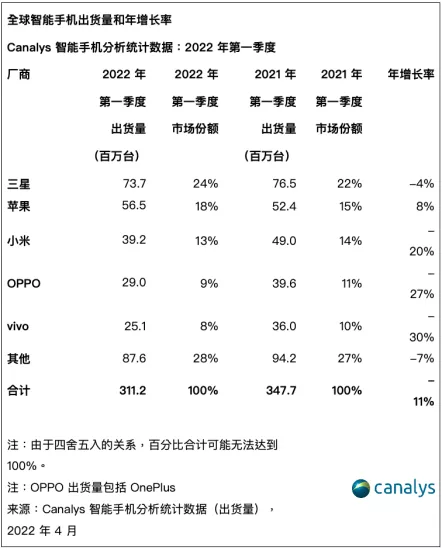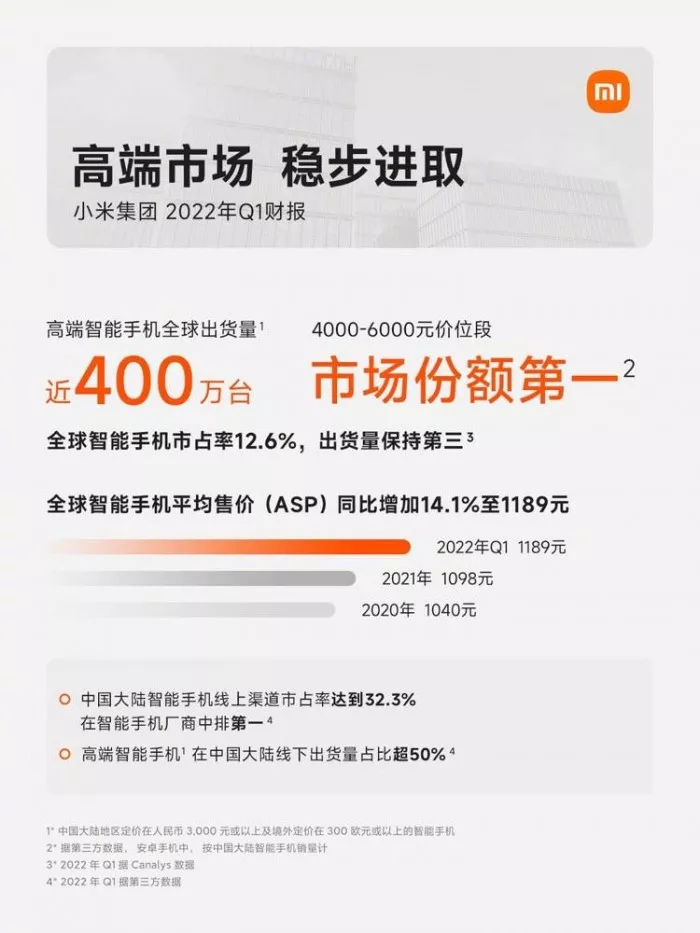Global smartphone shipments are down, and Xiaomi is inevitably affected by the environment. On May 19, Xiaomi released its first quarter financial report, with a total revenue of 73.4 billion yuan and an adjusted net profit of 2.9 billion yuan. The growth rate of total revenue and adjusted net profit fell to varying degrees.
This is mainly caused by the superposition of many adverse factors such as the repeated COVID-19, the uncertain international situation, the shortage of core parts and components, which affect the shipment of smart phones. It is also an industry dilemma faced by all smart phone manufacturers. Canalys pointed out that global smartphone shipments fell 11% year-on-year in the first quarter of 2022. According to the data of the information and Communications Institute, the domestic mobile phone shipments from January to March decreased by 17.7%, 31.7% and 40.5% year-on-year.
However, under the difficulties, Xiaomi group is still making steady progress: the smartphone business has made further breakthroughs in the high-end market, and the smartphone market share in the price range of 4000 yuan to 6000 yuan ranks first among Android smartphone manufacturers; Xiaomi's global MIUI monthly live users reached 529 million, a year-on-year increase of 104 million; The number of Xiaomi aiot connected devices (excluding smartphones, tablets and laptops) reached 478 million, a year-on-year increase of 36.2%.

In the environment of superposition of many adverse factors, the common concern of the market and industry is: how can Xiaomi resist risks and make a breakthrough in business? Can the business breakthrough drive Xiaomi to achieve long-term steady growth?
The essence of these questions is what kind of technology companies have stronger anti risk ability under the pressure of the general environment.
Sun Yanbiao, President of the first mobile phone industry research institute, believes that the sales of all domestic mobile phone brands decreased in the first quarter compared with last year, which shows that this round of epidemic has a great impact on the domestic mobile phone market. As the tide recedes, Xiaomi still sits firmly on the "throne" with the world's third largest shipment volume, and its anti risk ability is the strongest among domestic manufacturers.
He believes that, on the one hand, Xiaomi's global layout is the most successful. Q1 of overseas market revenue accounts for 51.1%, surpassing the domestic market, sharing the "pressure" to a certain extent. On the other hand, Xiaomi's product line is also the most complete. "The core of the mobile phone market is the channel. Facing the cold winter of the mobile phone market, mobile phone manufacturers have launched more product lines to avoid the 'loss' of channel providers, so as to maintain the stability of the market system. Xiaomi has been laid out in the IOT market for many years, with the most complete product lines and strong first mover advantage."
High end, new increment of mobile phone business
The downward trend of smartphone shipments is not something that a mobile phone manufacturer can resist on its own.
Wang Xi, China Research Manager of IDC, pointed out that the repeated outbreaks in important domestic cities have continued to affect the consumer sentiment of consumers across the country on non essential consumer goods, including mobile phones. In addition, the prospect of some overseas key markets is still uncertain, and the continued high cost of core components will enable many mobile phone manufacturers to adopt more stable and conservative operation strategies.
Under such adverse effects, it is unrealistic to blindly ask mobile phone manufacturers to increase shipments. In contrast, what is more important is how to minimize the impact. This is also the way for Xiaomi to survive under the pressure of the environment.
On the one hand, it is to maintain the original market share as much as possible. Canalys data show that in the first quarter of 2022, Xiaomi is still the largest smartphone market share in the world, second only to Samsung and Apple The third largest mobile phone manufacturer, and basically maintained the original market share. When the shipments of domestic mobile phone manufacturers fell sharply, Xiaomi's decline was the smallest.

In addition to maintaining market share, what is more important is how to offset the risks to revenue and profits when shipments decline. Xiaomi chose the high-end route to resist the impact of short-term sales decline by increasing the unit price.
At the beginning of the year, Lei Jun, the founder, chairman and CEO of Xiaomi, once again made it clear that the high-end road is the only way for Xiaomi's growth and the battle of life and death for Xiaomi's development. Xiaomi should fully benchmark its products and experience iPhone , won the first market share of domestic high-end mobile phones in three years.
From the performance of the first quarter, Xiaomi achieved remarkable high-end results. The financial report shows that. Global shipments of high-end smart phones priced at more than 3000 yuan by Xiaomi reached nearly 4 million units, and ASP was 1188.5 yuan, a year-on-year increase of 14.1%. On May 23, Xiaomi officially announced that it had reached an unprecedented strategic cooperation with Leica, a famous German camera brand, and the first image flagship mobile phone jointly developed with Leica will be officially launched in July this year. This high-end flagship jointly developed by Xiaomi and Leica will also enable Xiaomi to explore a very considerable range of ASP in the whole year on the basis of the first quarter.

The offline channel reform vigorously promoted by Xiaomi last year also provides great help for high-end. It is worth mentioning that in the first quarter, Xiaomi's high-end smartphones accounted for more than 50% of the offline channel shipments in Chinese Mainland. This means that offline stores with a weak sense of existence in the past are bringing new increment to Xiaomi's high-end market.

Canalys analyst Liu Yixuan commented that the expansion of offline stores was helpful to the transformation of medium and high-end sales, and increased the internal proportion of Xiaomi brand relative to redmi year-on-year.
Changjiang Securities believes that the high-end of Xiaomi is not only reflected in the increase of price, but also has undergone positive changes in R & D investment, channel layout and marketing strategy. With the operation of thousands of stores opened in 2021 becoming mature, Xiaomi's offline market share may be further improved.
The results brought by Xiaomi's offline channel reform are showing, which means that Xiaomi's high-end route moves from strategic attempt to strategic attack.
Mobile xaiot strategy shows synergy
In the first quarter financial report, the development of aiot was no small bright spot. The income of IOT and consumer products reached 19.5 billion yuan, a year-on-year increase of 6.8%.
In Lei Jun's plan, the core business of mobile phones and the ecological layout of aiot are "equations that can cause mass energy conversion". Mobile phone has always been the core business of Xiaomi, which is related to the success or failure of Xiaomi's business and the cornerstone of Xiaomi's business model. Last year, Xiaomi upgraded mobile + aiot to mobile x aiot.
Under the "mobile phone xaiot" strategy, Xiaomi aiot and mobile phone business are enabled in both directions, and the interconnection experience is upgraded to Xiaomi intelligent ecology to win more users, which is also the booster of mobile phone business.

For example, in the context of three consecutive quarters of year-on-year decline in global TV shipments, Xiaomi TV shipped 3 million units in the first quarter, with a year-on-year increase of 15%, and the growth of TV sales is benefiting from the help of Xiaomi ecology. According to Hu Qimu, chief researcher of Sinosteel Economic Research Institute, in the era of Internet of things, mobile phones are only one of the terminals, and the Internet integration and service capability behind intelligent terminals are the core competitiveness of enterprises.
Driven by the growth of shipments of aiot equipment such as TV, Xiaomi's aiot connection equipment also reached a new high. By the end of March, the number of aiot connected devices of Xiaomi had exceeded 478 million, with a year-on-year increase of 36.2%.
The continuous growth of Xiaomi aiot data can not only provide traffic support to Xiaomi home, but also promote the continuous sales of Xiaomi mobile phones ecologically. Zheshang International believes that Xiaomi has formed a strategic complementary relationship with aiot with smart phones as the core. In addition, with its diverse hardware devices and massive user base, Xiaomi realizes further data precipitation and ecological chain development, which in turn feeds the virtuous cycle of smartphone and aiot business, taking the lead in the era of Internet of all things.
The increment of aiot business can also come from the intelligent upgrading of the whole house in scenarios such as families and hotels. Sui qian, senior director of strategy analytics, believes that the smartphone industry has been relatively stable for more than ten years, and it is difficult to make a breakthrough. More than 90% of them are sold to replacement users. However, the life cycle of IOT products is different from that of mobile phones. The development time is later. There are a lot of first-time buyers and there is more room for growth. Now, all manufacturers hope to establish an ecosystem, because mobile phones and IOT products have strong synergy. If the interconnection experience is good, IOT business development can in turn drive the development of mobile phone business, which is of great help to improve the stickiness of users.
Deep ploughing technology, millet makes steady progress
For enterprises, the more complicated and turbulent the situation is, the more they should remain calm and sober, not affected by short-term fluctuations and focus on long-term development.
What does Xiaomi rely on to achieve long-term growth?
Liu Yixuan believes that high-end is a strategy suitable for Chinese manufacturers in the current market environment. At the same time, it is not so easy to go. It needs to be jointly promoted from R & D strength, brand image and channel resources. For Xiaomi, a brand developed from volume and cost performance, it is important to accumulate R & D capabilities and consider how to make good use of brand assets and its own genetic advantages to promote high-end products.
This is what Xiaomi is practicing: in the face of short-term environmental fluctuations, Xiaomi is still down-to-earth, deeply ploughing technology research and development, and consolidating the moat.
Under the pressure of income, Xiaomi's R & D investment still maintained a year-on-year growth. In the first quarter, Xiaomi's R & D expenditure was 3.5 billion yuan, a year-on-year increase of 16.0%, including 425 million yuan of innovative business expenses such as intelligent electric vehicles.
With unremitting technical investment, Xiaomi has achieved breakthroughs in many fields. As of March 31, 2022, Xiaomi had more than 26000 global patent authorizations and more than 53000 global patent applications.
The investment in technology research and development has also continued to bear fruit. In the image field, the Xiaomi owl algorithm team won two World Championships in the CVPR ntire night scene rendering competition known as the "image algorithm Olympics" due to overcoming many difficulties in taking photos at night. In terms of charging technology, Xiaomi's first 120W single cell second charging and 200W wired charging technology have also been widely recognized by people in the industry.
In the final analysis, the investment in technology is also the attention to talents. Xiaomi's emphasis on talents is also in the forefront of technology companies. In March, Xiaomi opened the largest employee incentive in history and granted 174.9 million shares to outstanding employees. According to the closing price of the shares on that day, each person will get 426900 yuan "big red envelope".
Wang Xiang, President of Xiaomi, said that it is a fact that the current epidemic has brought difficulties to Xiaomi's performance. However, the epidemic will pass, and Xiaomi will continue to invest in key areas to improve operational efficiency.
In terms of automobile business, Xiaomi still maintains the original delivery plan. It is expected to be officially mass produced in the first half of 2024 and is going all out as planned. In the future, the auto business is expected to become an important revenue growth point of Xiaomi.
It can be said that Xiaomi is investing in the future and seeking long-term sustainable development.
Summary
Affected by the shortage of core parts, repeated COVID-19, changes in the international situation and other aspects, Xiaomi's overall performance fluctuated to a certain extent, but it was not easy to resist the risks and achieve results in high-end mobile phones, TVs and other markets.
In the steady investment in technology research and development, Xiaomi, which sticks to hard technology, is likely to continue to consolidate its technical advantages, achieve more breakthrough innovation and create business travel alienated products, so as to further develop in the high-end market.
When the epidemic situation is gradually stabilized and the supply of chips and other parts is gradually restored, Xiaomi is not far from new growth.